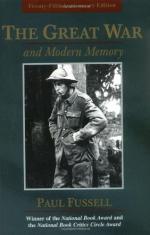
|
| Name: _________________________ | Period: ___________________ |
This test consists of 15 multiple choice questions and 5 short answer questions.
Multiple Choice Questions
1. What was the difference between British commanders Haig and Plumer?
(a) Imagination.
(b) Training.
(c) Strategic planning.
(d) Experience.
2. The last of the volumes of Siegfried Sassoon's works is called _____.
(a) Siegfried's Journey.
(b) Siegfried's Journey Through Life.
(c) Siegfried's Life.
(d) Siegfried's Travel.
3. What are some different types of trenches called?
(a) Firing trenches.
(b) All answers are correct.
(c) Saps
(d) Communication trenches.
4. According to Fussell, modern war requires an accompanying ______.
(a) Peace.
(b) Literature.
(c) Language.
(d) Innocence.
5. In what month was the peace armistice signed for World War I?
(a) October.
(b) September.
(c) November.
(d) August.
6. Within the trenches, how many lines of troops were stationed there in war time?
(a) Two.
(b) Three.
(c) Four.
(d) Five.
7. What is the title of the final volume of the trilogy?
(a) Memoirs of an Infantry Officer.
(b) Memoirs of a Fox-Hunting Man.
(c) No answers are correct.
(d) Sherston's Progress.
8. About how far from the enemy were the first line of troops stationed in the trenches?
(a) One hundred fifty yards.
(b) Fifty yards.
(c) Two hundred fifty yards.
(d) Two hundred yards.
9. When was the final volume of the trilogy written?
(a) Civil War.
(b) The Great Depression.
(c) World War I.
(d) World War II.
10. One store that had a gift assortment that could be sent to men at the front was _____.
(a) Macy's.
(b) JC Penney.
(c) Harrods.
(d) Sears.
11. At the beginning of World War I, who was the British commander?
(a) Thomas Hardy.
(b) General Sir George Plumer.
(c) Sir Douglas Haig.
(d) George Sherston.
12. Before World War I, how many years had it been since Britian was engaged in a major war?
(a) Fifty years.
(b) One hundred years.
(c) Two hundred years.
(d) One hundred fifty years.
13. What trench was the shallowest and used to advance a position?
(a) Firing trench.
(b) Sap.
(c) No answers are correct.
(d) Communication trench.
14. According to Fussell, personalities change as people are exposed to _____.
(a) War.
(b) Drugs.
(c) Weapons.
(d) Rumors.
15. What are the prolonged implications from soldiers forced in the trenches for a long period of time?
(a) Social.
(b) All answers are correct.
(c) Psychological.
(d) Political.
Short Answer Questions
1. What were these trenches called?
2. During World War II, where did many soldiers fight from?
3. What was the title of the poem that spoke of the symbolization for the colors for hospitalization and injury?
4. What did the British commander think the 1916 battle against Germany would do?
5. What was the last line of the trenches referred to as?
|
This section contains 414 words (approx. 2 pages at 300 words per page) |

|




